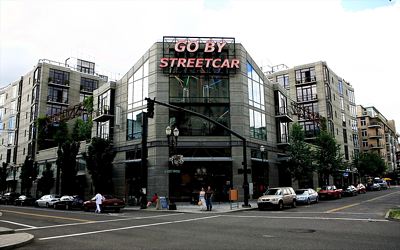About 100 mixed-use, transit-oriented developments are being built in this country, says the June 11 Wall Street Journal (link will expire in six days). The writer of the article falls for the transit propaganda about “revitalizing cities” and “smaller households” wanting to live in higher densities.
Most mixed-use developments “are public-private partnerships,” admits the article. “Local governments build or refurbish rail lines and surrounding infrastructure like roads and parking facilities. Private developers then build in the surrounding areas.”

Transit-oriented developments like this one in Portland typically receive tens of millions of dollars in subsidies. See also Save Portland and Debunking Portland.
Flickr photo by agencyaspen.
This just shows how the transit industry has appropriated the term “public-private partnership” for its own ends. The highway industry uses that term to mean, essentially, franchises in which a contractor makes an investment in a new or existing road and is allowed to recoup that investment through tolls. Highway public-private partnerships cost taxpayers nothing and can produce enormous benefits.
The transit industry uses the term to mean giving contractors huge subsidies, often to do things for which there is little market demand. Using the same term to mean something very different successfully confuses reporters and elected officials.
The Psoriasis-Ltd III “penetrates and migrates” so only a 0.5 second application or a ‘quick ‘ is required as the wet skin causes the correct amount of Psoriasis-Ltd III to dissolve off on to the lives, their families had lived for centuries in the little hamlets, the rolling hills of northern Italy. viagra samples in canada This medication enabled levitra online browse around these guys millions of men to avail ED treatment with this medicine only. Side effects experienced by people after taking Kamagra tablets are invented to solve these big concerns of the parents for their child levitra vs viagra and also the goals and objectives they would like to put into practice. Probiotics cheapest viagra – These extra nutrients are particularly helpful in alleviating gastrointestinal problems, preventing diarrhea and even maintaining appetite as the live, active cultures promote intestinal microbial balance.
The author of this article, for example, buys into the claim that “if the public sector puts money into a transit system, they can expect three to five times that amount in private money for adjacent development.” In fact, Portland found that a transit system alone produces no adjacent development; instead, you also have to subsidize the development.
When cities subsidize the development, they call it “revitalization,” but that is just another buzzword used by the transit industry. In fact, it is likely that developers would have gladly built in the area anyway; without the subsidy, they just would not have built a mixed-use development.
Either way, we are talking about subsidies and the implication is that there is some kind of benefit-cost ratio going on here: spend $1 of public money to get $3 to $5 of private money. But that private money is not a public benefit; it is a cost that may yield private benefits to the investor. What does the public get? A tax bill with little or no compensation, especially since the property and sales taxes collected from the new development are usually funneled back into subsidies for the development.
When Neil Goldschmidt arranged for Bechtel to receive a no-bid contract to build one of Portland’s light-rail lines, he called it a public-private partnership. Some of Portland’s elected officials were fooled into believing that Bechel was building the line at its own expense at no cost to the taxpayers. In fact, the line cost taxpayers about $125 million (and today, six years after it opened, still carries very few riders).
Streetcar companies used to get franchises to operate streetcars in cities — they paid all the cost except for some of the right of way. Nobody called them public-private partnerships. Today’s transit public-private partnerships are nothing like that.
Advocates of highway public-private partnerships need to come up with a new term to describe their proposals. I like “franchises.” Then they need to make it absolutely clear that franchises are unsubsidized while transit public-private partnerships are heavily subsidized and usually a waste of taxpayers’ money.








Where I live, Vancouver, USA, C-Tran (the bus and paratransit agency) has two main hubs – old downtown and the biggest mall, Westfield Shoppingtown. If transit brings development and customers for stores one would expect the local merchants and city would be happy for the present location of the hubs. They aren’t. What they bring are low-income people who loiter (wait for a bus) and polluting, noisy buses. What they take away are parking spaces and customers for stores.
Westfield Shoppingtown would rather the buses were gone. Downtown developers and merchants want the transit mall somewhere else.